Delphi, assumed once as the center of the world, is one of the most prominent locations of Ancient Greece. Known also as Pytho in ancient times, Delphi was the epicenter of Greek antiquity due to its significant role in daily, cultural, and spiritual life. This was the seat of Pythia, the most famous oracle of antiquity. It was Pythia who consulted ancient Greeks before wars or critical decisions. Moreover, in Delphi (Greek: Δελφοί), one can visit the legendary Temple of Apollo, the Castalian Spring, and the Tholos.
A UNESCO World Heritage Site, Delphi is today one of the most-visited locations in mainland Greece. Apart from the archaeological site itself, there’s also a brilliant museum presenting, among other findings, the Charioteer, known as Heniokhos. As you can imagine, no journey to Greece is complete without a visit to Delphi.
That said, in this article, you’ll find plenty of interesting facts about Delphi accompanied by several photos. There’s also a short 4K video where you can see my walk through the sacred precinct. Moreover, you will see the best tours to Delphi, and I’ll also share the best accommodation options in the wider area.
This guide is structured around the needs of first-time visitors. However, if you have previously visited Delphi, you will find lots of info and travel ideas about your stay. Therefore, navigate through the sections of this travel guide to Delphi and see how life in ancient Greece unfolded.
Let’s start.
*The text contains affiliate links. It means that if you buy something, I might earn a small commission at no additional cost to you.
The ultimate travel guide to Delphi, Greece
After watching the 4K video above, you probably have an overview of what the sacred precinct looks like. Now, it’s time to dig deeper into the things you need to know before visiting Delphi. So, here you’ll find some interesting facts about Delphi that will help you understand better the famous antiquity spot.
10 interesting facts about Delphi
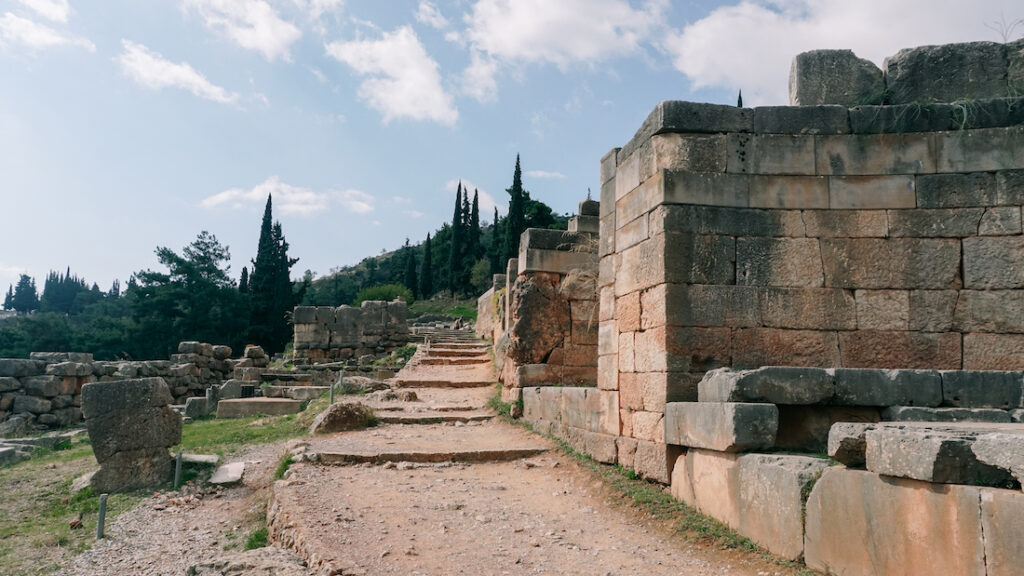
Where in Greece is Delphi?
Delphi is located approximately 2 1/2 hours away from Athens in the region of Phocis. Adjacent to the ancient location, there’s also a modern town under the same name. Delphi lies on the slopes of Mount Parnassus at an altitude of 632 meters (2073 ft). Although there are several villages in the area, the closest cities are Amfissa and Livadeia.
On the southern part, you can see the Desfina peninsula, leading to Corinth’s Gulf.
What is the navel of the Earth (or Omphalos)?
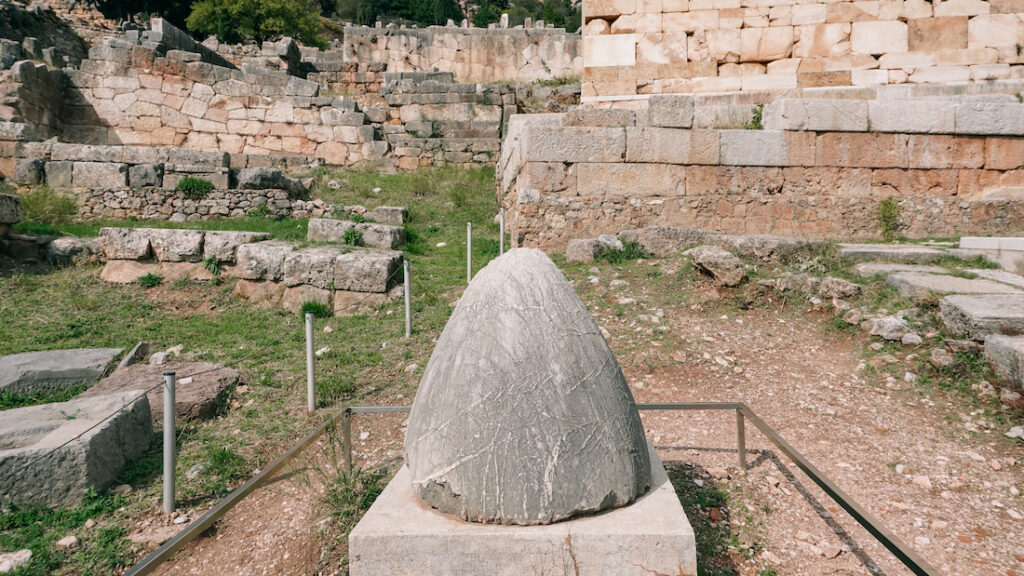
The so-called Omphalos (navel) is a marble monument that you can see shortly after walking the Iera Odos. What you see on-site is actually a simplified copy and not the original. However, you can see the actual navel of the Earth on the Museum’s premises.
Scholars debated the authenticity of the Earth’s navel. Some claimed that the one exhibited in the Museum is authentic, while others believed it was a copy from the Hellenistic or even Roman era. Nowadays, it is assumed that it’s indeed a copy from a later era.
According to Pausanias, a woolen cloth covered the stone, and on its top, two gilded eagles were standing. Those eagles probably refer to Zeus. In Greek mythology, when Zeus searched for the center of the Earth, he set free two eagles from the world’s edges -east and west. Supposedly, the eagles started flying at the same speed and at the same time. The meeting point of the two eagles was Delphi, and that’s how Zeus placed the stone.
Thus, Delphi became, for Greeks, the navel of the Earth or Omphalos (Greek: ομφαλός της Γης).
The oracle of Delphi: facts and prophecies
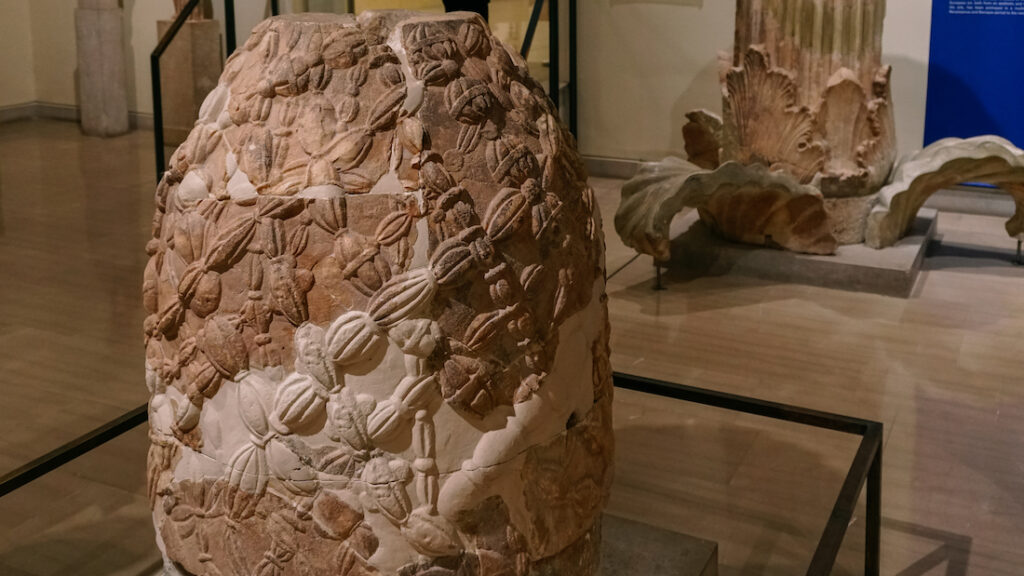
When we talk about the Oracle of Delphi, we refer to the high priestess of the Temple of Apollo. Her name was Pythia and most likely derives from Pytho, which was Delphi’s original name. As for the origins of Pytho, this comes from the ancient verb πύθειν (pithein). It means “something that rots,” a direct reference to the odor of the decomposed body of Python, a monstrous serpent killed by Apollo.
The role of Pythia was given to older women who lived blameless lives. Between the 8th century BC and the 4th century AD, Pythia was the most famous oracle of ancient Greece. There’s always an ongoing debate on the way Pythia spoke her oracles. Supposedly, Pythia would bathe naked in the nearby Castalian Spring, drink water from Cassotis, and then the Oracle would reach into the adyton. There, on a tripod seat, Pythia held laurel leaves and would enter in some sort of trance.
Then, Pythia was in ecstasy and uttered incoherent cries and speeches. The priests of the oracle turned these inarticulate words into oracles, and their meanings were always ambiguous.
For example, one of the most famous prophecies attributed to the Delphic Oracle is “ήξεις αφήξεις ουκ εν τω πολέμω θνίξεις.” The phrase translates to “You will go you will return not in the war shall you die.” However, the phrase has a dual meaning depending on the comma’s position. That said, it can translate t0 “you will go, you will return, not in the war shall you die”; therefore, you won’t die in the war. But, if you add the comma after not, you’ll get “you will go, you will return not, in the war shall you die.”
And here’s some trivia regarding the Oracle of Delphi: the name of the first Pythia was Phemonoe, a famous Greek poet of the ante-Homeric period. Although it’s hard to prove it, according to some studies, the famous phrase “know thyself” (Greek: γνῶθι σεαυτόν) is attributed to Phemonoe. The phrase is inscribed at the Temple of Apollo at Delphi.
The temple of Apollo in Delphi
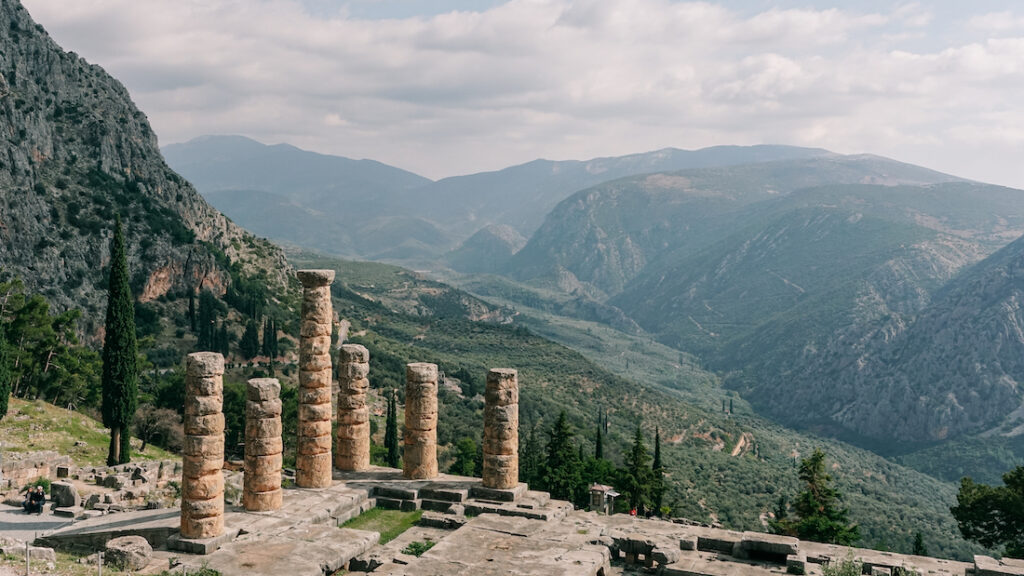
As you can easily imagine, the temple was the most important building in the location. Pythia operated inside the Temple of Apollo. What’s not so well known is that several temples were dedicated to Apollo before the one we see today.
According to Greek mythology, for the first temple of Apollo, they used just laurel branches. The second temple was constructed with even weirder materials: beeswax and feathers. However, the third was -finally- made of copper. As for the fourth one, it was built by the famous architects Trophonius and Agamedes, and according to the myth, Apollo himself helped them. This temple was made of stone, but a fire destroyed it in 548 BC.
That said, the Temple of Apollo that we currently see took its form later. So, the new temple was built by the Alkmaeonid, an Athenian aristocratic family. The Alkmaeonid family was in exile after the decision of the tyrant Peisistratos. The temple’s completion took place around 511 BC. It was of Doric order and had a six by fifteen column peristyle. However, an earthquake destroyed the temple, too, and it took almost two centuries to get proper restoration.
Unfortunately, the temple looks in relative decay today, and that’s because of the material used. The limestone used is a much shorter material, and the Temple of Apollo at Delphi doesn’t seem to be in the condition of other nearby findings made by marble.
What’s the Sacred Way (or Iera Odos)?
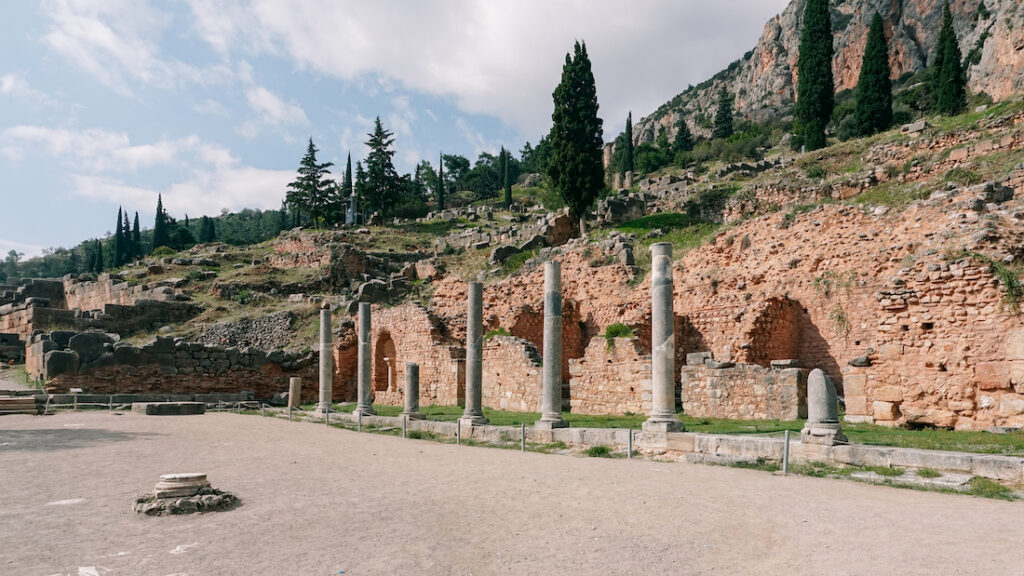
The Sacred Way, known as Iera Odos, is the main road leading from the entrance to the Temple of Apollo. Despite its existence during the archaic period, the Sacred Way of Delphi was paved only during the late Roman period. They used slabs from abandoned buildings found in the area.
The Sacred Way deserves a special mention because it’s the road the visitor will take to visit all the places of interest. That said, you will walk the same route that the locals used thousands of years ago.
Although just a few things are left today intact, one should imagine statues and treasuries on the street’s side. Some of them commemorated the winners of the Delphic Games, while others referred to military victories.
The ancient theater
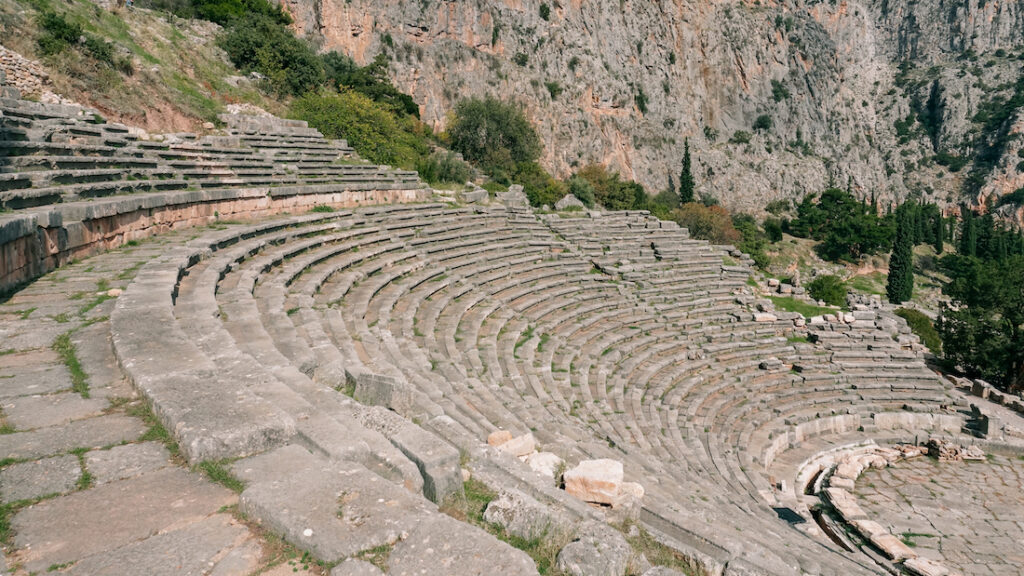
As you walk past the Temple of Apollo and further up the hill, you’ll come across the ancient theatre at Delphi. Dating back to the 4th century BC, the theater had an orchestra of 7 meters in diameter. While it’s not as impressive as the Epidaurus Theater, it also had two Parodoi, which served as access points. In addition, it had two zones, called Diazoma, that hosted the spectators during plays. The lower one had 27 rows of seats, but the upper one had just 8. The theater’s capacity was approximately 4,500 people.
The theater of Delphi hosted vocal and musical contests, and it was a venue for the Pythian Games.
The Stadium of Delphi

After crossing the theater and all the way to the hill’s top, you’ll see the Stadium. It enjoys a spectacular view of the Delphic landscape and is the most well-preserved ancient Stadium in Greece.
Built back in the 4th century BC, the Stadium of Delphi has a length of 178 meters. Of course, it was the Stadium of the Pythian Games, and several gymnastic contests took place there. As far as we know, the Stadium at Delphi had a capacity of 6,500 spectators, and on its northern side, we can still see 12 rows of seats.
The Tholos of Delphi (Athena Pronaia)
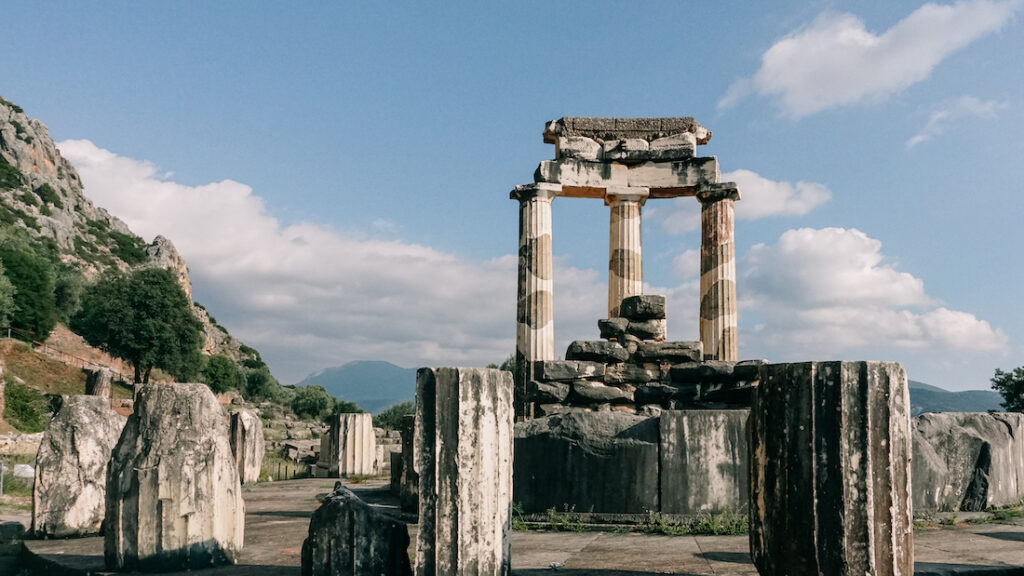
About a kilometer from the main archaeological site, you can also visit the Tholos of Delphi. That’s the sanctuary of Athena Pronaia, an impressive circular temple. Constructed between 380 and 360 BC, the Tholos has twenty Doric columns arranged in its exterior, while 10 Corinthian columns are in the interior.
Its architect, Theodorus Phoceus, wrote a book explaining everything about the building. The dome had several beautiful sculpted decorations, but unfortunately, we don’t know anything about their creators.
The Archaeological Museum of Delphi
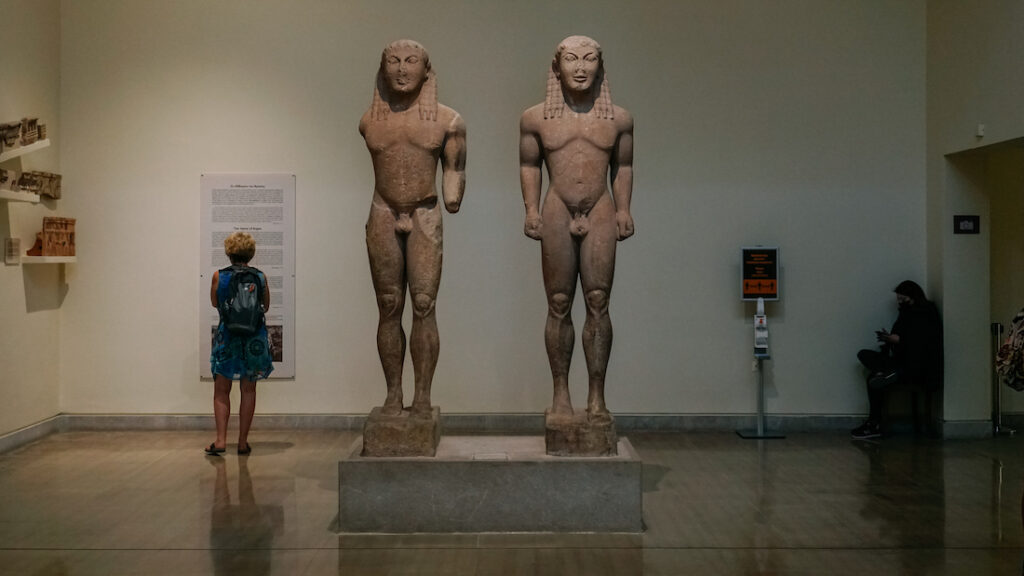
Attached to the archaeological site lies the beautiful Museum of Delphi. A visit to the Museum is a must, and there’s no separate entry fee. The excavations revealed a wealth of findings, and there are some impressive discoveries to admire. The most famous of all is the Charioteer of Delphi, known as Heniokhos, but also Kleobis and Biton, two ancient Greek Kouros. The Sphinx of Naxos is also part of the Museum’s collection, and, of course, the original Omphalos, the navel of the Earth, is also inside the Museum.
You can see more info about the Museum here.
How did the story of Delphi come to an end?
Once the center of Delphic Amphictyony, the Temple of Apollo and the surrounding area slipped into decay after the rise of the Roman Emperors. It was Emperor Theodosius in the 4th century AD that decided to shut down the Oracle. In the following centuries, the area declined further, and it was abandoned during the Slavic invasions.
How to visit Delphi: by car or on a day tour from Athens
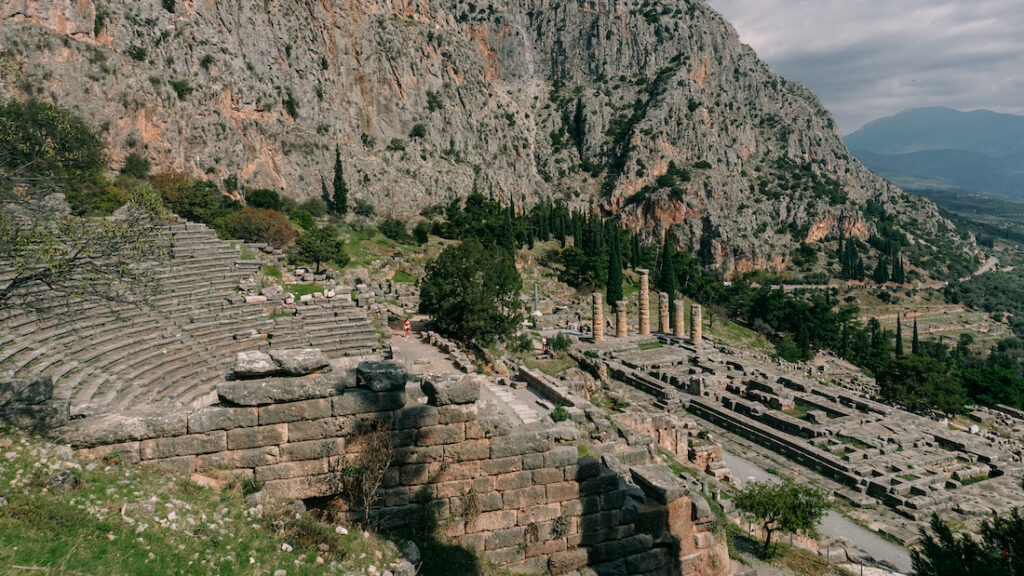
Delphi is approximately 180 kilometers (112 miles) away from Athens. The easiest way to visit Delphi is by car. The journey is pleasant, and you’ll have to drive through the motorway for the most part. Car’n’Motion offers the best prices for renting a car in Greece. Simply add your starting point and see prices and availability. You can rent your car here.
However, if you prefer to have somebody else drive for you, many tour operators offer day trips to Delphi. Below, you will find a handpicked selection of day trips to Delphi, accompanied by a short description of their services. In case you would like to spend more days in the region, you’ll find two multi-day tours that will drive you around the area.
Delphi day trips
Guided day trip to Delphi with pickup and optional lunch. This is one of the best day trips you can book. The price includes the entrance fee, and there’s an optional lunch break. Moreover, on the way back to Athens, you will stop at Arachova as well. See prices and availability for this guided tour here.
Full-day tour to Delphi. Pretty similar to the previous tour, it includes entry fees and an optional lunch. It also starts from Athens, and there’s also a stop at Arachova on the way back. See the tour here.
Private walking tour to Delphi. For this tour, you will have to reach Delphi on your own. That said, it doesn’t include transportation from and to Athens like the previous ones. However, a professional guide will walk you through the ancient sanctuary of Delphi and will explain to you everything you need to know. Of course, admission fees for both the archaeological site and the Museum are included. Book this private tour here.
Delphi and Meteora: 2-day guided tour. That’s the first of the multi-day tours that you can book. If you book this tour, you’ll have to option to visit Delphi and the breathtaking monasteries Meteora, perched high above the stunning countryside. They will pick you up from your hotel in Athens, and the price includes a hotel room for one night, plus breakfast and dinner. Check the prices for the 2-day tour here.
Classical Greece: 4-days tour. Finally, if Delphi is not enough for you and you’d like to see more of Classical Greece, that’s hands down the best tour you can book. Starting from Athens, you’ll visit the most important places in mainland Greece. Specifically, you’ll see (hold your breath) Epidaurus, Nafplio, Mycenae, Ancient Olympia, Delphi, Arachova, and the Meteora Monasteries. The price includes admission fees, hotel rooms, plus breakfast and dinner. See the 4-day tour here.
Where to stay in Delphi
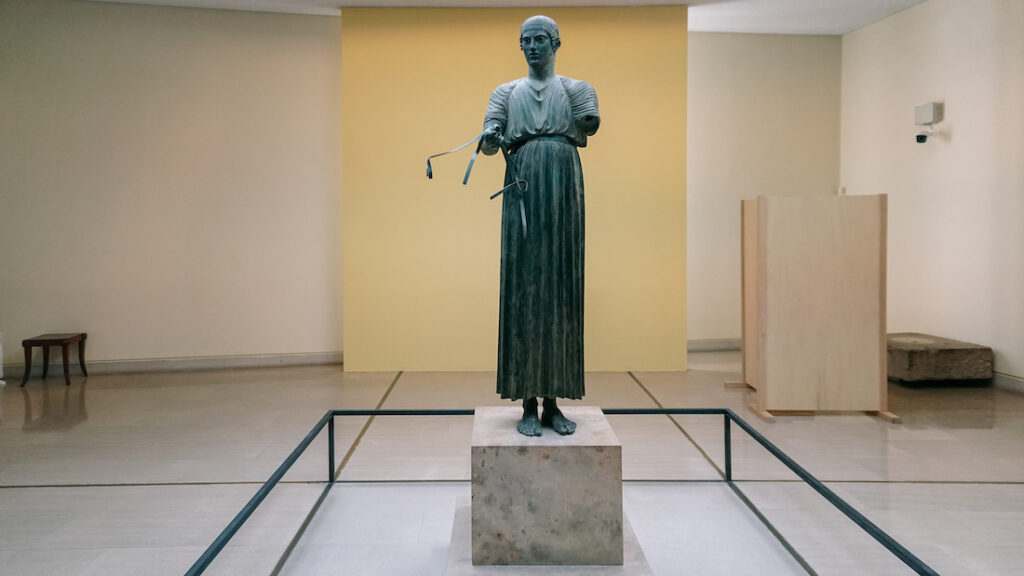
Last but not least, no travel guide to Delphi is complete without the best hotels in the region. While you cannot stay straight at the archaeological site, there are plenty of options in the nearby area. Depending on your traveling style, you have three options:
- Arachova. A picturesque and posh village 20 minutes away from the archaeological site. It’s also very close to a famous ski center.
- Delphi town. The modern Delphi settlement lies 2,5 kilometers away from the site.
- Galaxidi. A coastal town at the Gulf of Corinth, approximately 40 minutes away from Delphi. It’s home to the oldest Nautical Museum in Greece.
I have visited all these places on different occasions. However, the weekend I visited Delphi, I preferred to stay in Galaxidi. The reason is that I like being closer to the sea. Apart from the sea view, it meant also that the weather was significantly milder. Don’t forget that Delphi is at an altitude, and therefore the nights can be cold if you visit off-season.
That said, I’ll share a selection of accommodations in all these places. For more accommodation options, feel free to use the interactive map at the bottom of this section.
Where to stay in Arachova
Ampolis Guesthouse. One of the finest accommodations in Arachova that won’t cost you a fortune. The rooms are stylish, and some have a fireplace. Located in the heart of Arachova, Ampolis is an excellent option for visiting Delphi and the nearby ski center. See prices and availability for Ampolis.
Likoria Guesthouse. Every room in Likoria comes with a fireplace, and the traditional touch of the rooms makes this guesthouse unique. Just off Arachova’s center, Likoria’s prices are reasonable for the services it offers. Check Likoria’s availability here.
Where to stay in Delphi town
Fedriades Delphi Hotel. That’s probably the most excellent option if you’d like to stay in the modern town of Delphi. The rooms are spacious, some of them come with a fireplace, and they are in the town’s center. See the prices for Fedriades Hotel here.
Where to stay in Galaxidi
Archontiko Art Hotel. That’s the place I stayed in Galaxidi, and it was a great choice. Just a couple of steps away from the sea, Archontiko is a beautiful hotel with spacious rooms. Every morning they serve organic breakfast in their garden. See Archontiko here.
Ganimede Hotel Galaxidi. Another excellent option for your stay at the coastal town of Galaxidi. Hosted in a 19th-century villa and just 200 meters away from the port, Ganimede also has a beautiful garden and clean rooms. See Ganimede Hotel here.
Delphi Travel Guide: Epilogue

Delphi is one of the most prominent locations of the ancient world and definitely deserves a visit. Whether you’re on a day trip to Delphi or include it in a long road trip around Greece, make sure to spend enough time in the area. The oracle of Delphi, the navel of the Earth, and the Temple of Apollo deserve a visit at a slow pace.
If you can only visit one place in mainland Greece, that should be either Delphi or Mycenae. It’s a tough call, but if you ask me, I’d probably go to Delphi.
More about Greece: One week in Greece: suggested itineraries, Ancient Corinth, The best day trips from Athens
Pin it for later

If you enjoyed this Travel guide to Delphi, please share it with your friends.
Last Updated on April 17, 2024 by George Pavlopoulos

Love Delphi. One thing you shouldn’t miss in Delphi is having dinner at a table on a restaurant balcony overlooking the valley below with incredible views out towards the sea. My biggest regret is that I didn’t visit the Corycian Cave. Hiking up/down to the cave would have been fantastic!
Hey John,
Ah, Delphi is a place of extreme beauty. It’s always fascinating visiting it. I didn’t have dinner nearby, I stayed at Galaxidi, but I know what you mean. The view is breathtaking, and I enjoyed it while driving towards the coastal towns of the Corinthian Gulf. There are so many things to explore that I think you need to visit it twice. Even hiking the area around Delphi ( I didn’t do it) should be a great experience.